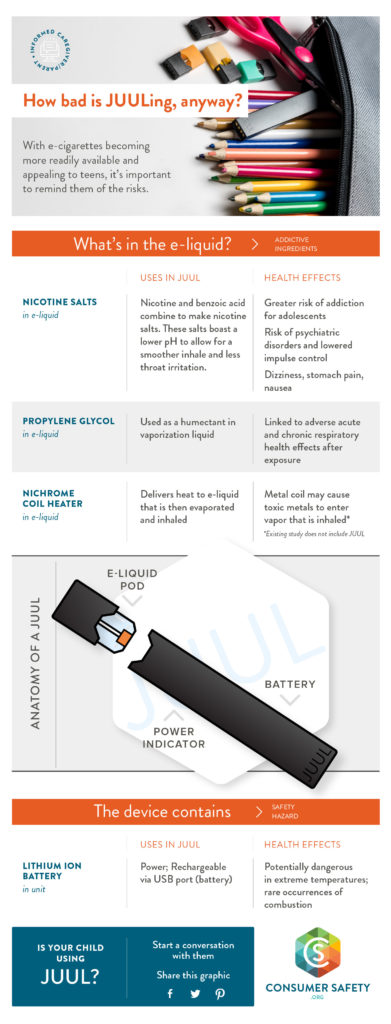E-Cigarette Ingredients Pose Health Risks For Teens

It is no secret that smoking is a habit that can lead to a plethora of health concerns. The makers of e-cigarettes hoped to change that fate, creating an alternative to inhaling the dangerous chemicals that can be found in conventional cigarettes. As a result, e-cigarettes have become the hub of a widespread craze, and the FDA now considers e-cigarette use an "epidemic" in young people.
Since e-cigarette brands like Juul have only gained popularity over the course of the last decade, researchers have yet to determine their long-term health impacts. For teens especially, vaping can have greater health implications, and with 75% more high schoolers using e-cigarettes in 2018 than in the previous year, the dangers of vaping addiction pose real risks to teenagers.
Scientific studies show that electronic cigarettes are a generally safer alternative to tobacco cigarettes, as they contain fewer and lower levels of toxicants than tobacco cigarettes. Although vaping involves inhaling vaporized liquid instead of the abundant chemicals found in tobacco, some studies question both the safety of extended e-cigarette use and its effectiveness in helping cigarette smokers break the habit altogether. So, how safe is vaping?
Which Ingredients Make E-Cigarettes Dangerous
It can be difficult to determine a direct link between serious health conditions and vaping, as the practice is relatively new and evidence is limited. Researchers suggest that the habit is not necessarily safer, but when e-cigs are used as a means to quit smoking, the chances of facing a smoking-related illness are greatly reduced. The drawback, however, is that instead of using it as a method to quit, individuals who pick up a recreational e-cig habit may be opening themselves up to nicotine addiction, Juul addiction, other drug addictions, and a variety of health issues.
We've created an infographic that takes a deeper look into Juul ingredients and what dangers they pose for consumers. You can also read more about the potentially dangerous ingredients in Juul vapes and other e-cigarettes below.
Propylene Glycol
Propylene glycol (PG), found in vape juice pods along with nicotine salts, is used to maintain moisture in the flavor pods and provide users with a smoother inhale. It is deemed "generally safe" by the FDA, but inhaling PG in excess can be a cause for concern. Though the chemical is found in cosmetics and even some foods, research shows that inhaling it over long periods of time can cause acute and chronic respiratory problems like wheezing and chest tightness. It can also disrupt circadian rhythm, causing sleep-related problems.
Nicotine Salts
The most addictive property in cigarettes, electronic or not, is nicotine. It naturally occurs in tobacco, but can be added to e-cigarettes, patches, and pills to imitate the effect of a traditional cigarette. This may be an effective method to help smokers quit, but it has proven to be equally addictive for individuals who haven't smoked prior to picking up an e-cig.
Although teen cigarette smoking is down in recent years, the use of e-cigarettes among young people has increased. Teens also have been found more likely to smoke if they have used an e-cig. Each Juul pod contains 59 mg/mL of nicotine, which is double the concentration of nicotine found in other e-cigarettes, making it highly addictive to their market of teens and young people.
Nicotine is not only addictive, but it also has an impact on memory, attention, and cognition. One study indicates that smoking at a young age leads to diminished psychomotor skills later in life. In the short-term, nicotine can negatively impact a child's ability to learn, and can later be responsible for a variety of mental and behavioral disorders.
Heavy Metals
Although vapers don't experience as many harsh chemicals as they would if they inhaled traditional cigarette smoke, they are still left vulnerable to inhaling chemicals that are unsafe. A recent study conducted by the National Academies of Sciences, Engineering, and Medicine found that people who use e-cigarettes may be inhaling dangerous levels of heavy metals like lead and nickel, which is a concern that conventional cigarette smokers also face. Some studies even obtained urine samples from individuals who vape, and found traces of the toxins that are present in the hardware of their e-cigarettes.
The metals that leak from the heated coils into the vapors can poison the body and cause cancer, heart conditions, brain damage, and other health concerns. Although the presence of heavy metals in e-cigarettes is lower than that of tobacco cigarettes, it can still be a potentially dangerous amount of metal to inhale when used regularly.
Understanding the Risks of Smoking
As e-cigarettes are becoming more and more popular, it is important to be mindful of their potential impacts on health. Although vaping is deemed a safer alternative than smoking cigarettes, the question of whether or not it is actually safe is yet to be determined. The lasting health effects of using a Juul, other e-cigarette products, and even e-cigarette addiction aren't well-known. E-cigarettes are a relatively new technology, but their addictive properties reel in teens and adults alike each time they choose to inhale.

